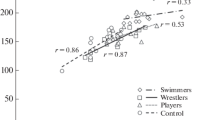Summary
A group of 9 Vietnamese physicians (V.) is compared with 9 Czechoslovakian physians (C.) of the same age. The V. group have average height of 162±2 cm and weight of 52±1.7 kg, a lower maximum Vo2/min. of 1827±314 which is not significant when expressed per 1 kg body weight, (33±5 ml). The respective values for C. are 175±2.2 cm, 77±2 kg, 3069±279 ml and 40±1.8 ml. Further there are statistically significant differences between both groups in ventilation, heart rate and RQ, during various degrees of work-load, but not in O2 consumption and efficiency of work at a work-load of 400–800 kg-m/min. The maximum aerobic capacity in the V. group is lower as compared with the C. group and a lower work capacity results from this. The causes of this difference are discussed.
Similar content being viewed by others
References
Andersen, K. L., andJ. S. Hart: Aerobic working capacity of Eskimos. J. appl. Physiol.18, 764 (1963).
Åstrand, I.: Aerobic work capacity in men and women with special reference to age. Acta physiol. scand.49 (1960) suppl. 169.
Åstrand, P. O.: Experimental studies of physical working capacity in relation to sex and age. Copenhagen: Munksgaard 1952.
Balke, B.: Circulatory-respiratory response to physical work. Performance capacity, a symposium. Washington: Nat. Acad. Sci. 1961.
Cullumbine, H.: Heat production and energy requirement of tropical people. J. appl. Physiol.2, 640 (1950).
Henry, F. M., andJ. C. de Moor: Lactic and alactic oxygen consumption in moderate exercise of graded intensity. J. appl. Physiol.8, 608 (1956).
Hollmann, W., u.H. W. Knipping: Die Bestimmung der menschlichen Leistungsfähigkeit vom Blickpunkt der Klinik. Health and Fitness in the Modern World. Athletic Institute University of Wisconsin, Madison, Wisconsin, USA 1961.
Joss, E.: Spiroergometrie bei Gesunden. Helv. med. Acta26, 24 (1959).
Mitchel, J. H., B. J. Sproule, andC. B. Chapman: The physiological meaning of the maximal oxygen intake test. J. clin. Invest.37, 538 (1958).
Peňáz, J.: Recording of physiological rhythmus by a new optical orthochronograph. Scr. med. Fac. Med. Brun.33, 1 (1960).
Robinson, S.: Experimental studies of physical fitness in relation to age. Arbeitsphysiologie10, 251 (1939).
Schilling, J. A., R. B. Harwey, E. L. Becker, R. Velasquez, G. Wells, andB. Balke: Work performance at altitude after adaptation in man and dog. J. appl. Physiol.8, 381 (1956).
Wyndham, C. H., N. B. Strydom, F. J. Morrison, J. Peter, C. G. Williams, G. A. G. Bredell, andA. Joffe: Differences between ethnic groups in physical working capacity. J. appl. Physiol.18, 361 (1963).
Author information
Authors and Affiliations
Rights and permissions
About this article
Cite this article
Škranc, O., Havel, V. Fitness of Czechoslovakian and Vietnamese physicians under graded work-load. Int. Z. Angew. Physiol. Einschl. Arbeitsphysiol. 20, 412–419 (1964). https://doi.org/10.1007/BF00695853
Received:
Issue Date:
DOI: https://doi.org/10.1007/BF00695853




